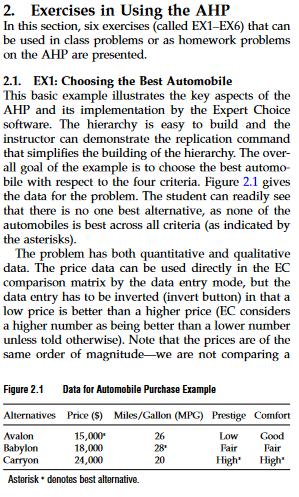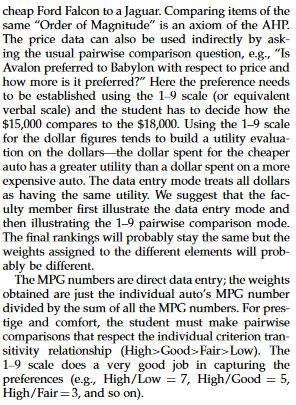Answered step by step
Verified Expert Solution
Question
1 Approved Answer
2. Exercises in Using the AHP In this section, six exercises (called EX1-EX6) that can be used in class problems or as homework problems


2. Exercises in Using the AHP In this section, six exercises (called EX1-EX6) that can be used in class problems or as homework problems on the AHP are presented. 2.1. EX1: Choosing the Best Automobile This basic example illustrates the key aspects of the AHP and its implementation by the Expert Choice software. The hierarchy is easy to build and the instructor can demonstrate the replication command that simplifies the building of the hierarchy. The over- all goal of the example is to choose the best automo- bile with respect to the four criteria. Figure 2.1 gives the data for the problem. The student can readily see that there is no one best alternative, as none of the automobiles is best across all criteria (as indicated by the asterisks). The problem has both quantitative and qualitative data. The price data can be used directly in the EC comparison matrix by the data entry mode, but the data entry has to be inverted (invert button) in that a low price is better than a higher price (EC considers a higher number as being better than a lower number unless told otherwise). Note that the prices are of the same order of magnitude-we are not comparing a Figure 2.1 Data for Automobile Purchase Example Alternatives Price ($) Miles/Gallon (MPG) Prestige Comfort. Avalon 15,000* 26 Low Good Babylon 18,000 28' Fair Fair Carryon 24,000 20 High' High' Asterisk* denotes best alternative. cheap Ford Falcon to a Jaguar. Comparing items of the same "Order of Magnitude" is an axiom of the AHP. The price data can also be used indirectly by ask- ing the usual pairwise comparison question, e.g., "Is Avalon preferred to Babylon with respect to price and how more is it preferred?" Here the preference needs to be established using the 1-9 scale (or equivalent verbal scale) and the student has to decide how the $15,000 compares to the $18,000. Using the 1-9 scale for the dollar figures tends to build a utility evalua- tion on the dollars the dollar spent for the cheaper auto has a greater utility than a dollar spent on a more expensive auto. The data entry mode treats all dollars as having the same utility. We suggest that the fac- ulty member first illustrate the data entry mode and then illustrating the 1-9 pairwise comparison mode. The final rankings will probably stay the same but the weights assigned to the different elements will prob- ably be different. The MPG numbers are direct data entry; the weights obtained are just the individual auto's MPG number divided by the sum of all the MPG numbers. For pres- tige and comfort, the student must make pairwise comparisons that respect the individual criterion tran- sitivity relationship (High>Good>Fair>Low). The 1-9 scale does a very good job in capturing the preferences (e.g., High/Low = 7, High/Good = 5, High/Fair=3, and so on).
Step by Step Solution
There are 3 Steps involved in it
Step: 1

Get Instant Access to Expert-Tailored Solutions
See step-by-step solutions with expert insights and AI powered tools for academic success
Step: 2

Step: 3

Ace Your Homework with AI
Get the answers you need in no time with our AI-driven, step-by-step assistance
Get Started


